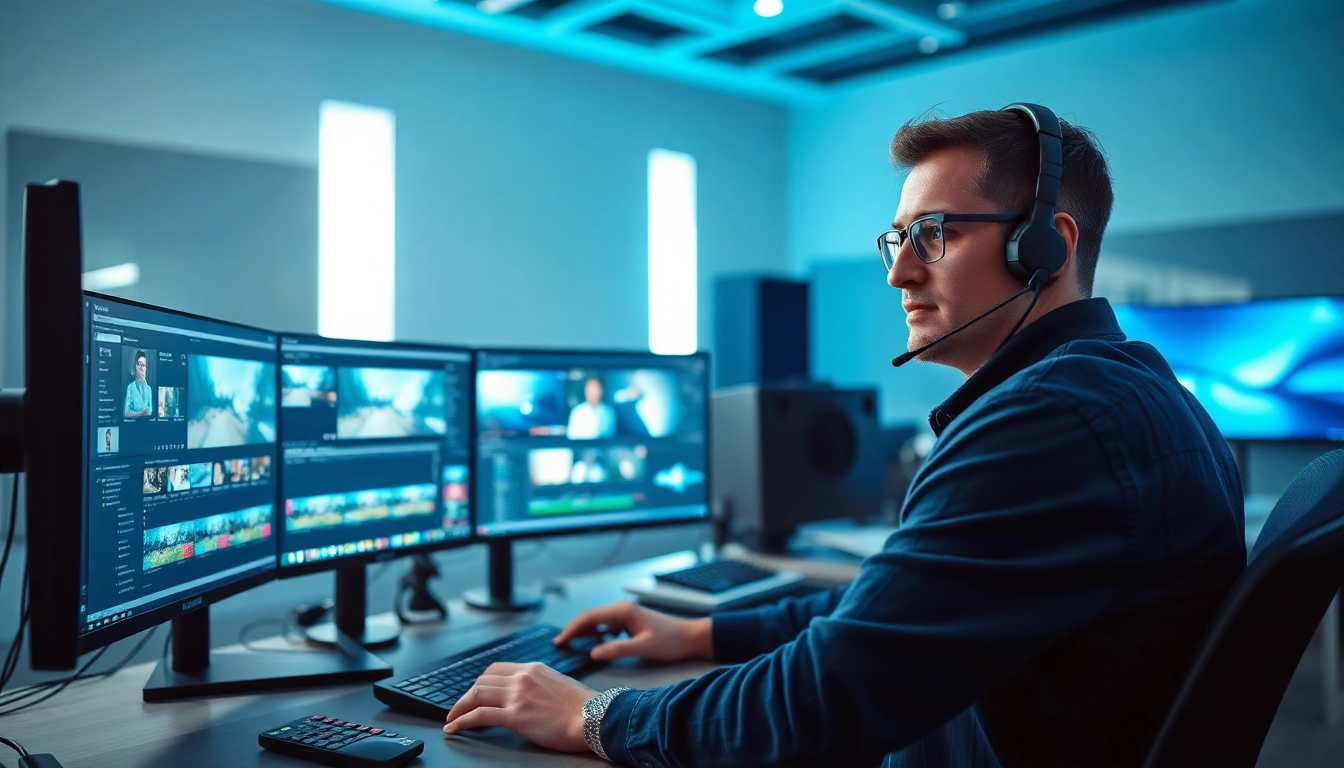Understanding the Basics of Editing & Post-Production
What is Editing & Post-Production?
Editing & Post-Production refers to the crucial phase in the video production process that occurs after the scenes have been filmed. It involves refining raw footage, enhancing audio quality, and incorporating effects to create a polished final product. This stage is essential not only for films but also for advertisements, documentaries, and online content. It transforms initial recordings into a narrative that resonates with viewers, hence the importance of mastering these techniques in today’s digital landscape. To dive deeper into how the editing & post-production can elevate your projects, feel free to explore more at Editing & Post-Production.
Key Stages in the Editing Process
The editing process is broken down into several stages, each playing a vital role in enhancing the overall quality of the visual and auditory experience:
- Logging and Organizing Footage: This initial stage involves reviewing all recorded materials, tagging important shots, and creating a structured database for easy access. Effective logging saves significant time during later editing stages.
- Rough Cut: The rough cut is a preliminary compilation of the film that lays out the basic structure. This version doesn’t incorporate sound effects or detailed color grading but allows for a better understanding of pacing and flow.
- Fine Cut: In this more advanced stage, editors begin fine-tuning the edit. This includes precise cut points, scene transitions, and beginning to layer audio assets. It is where footage starts to resemble the final edit.
- Color Grading: This involves adjusting the contrast, brightness, and colors of the footage to create a cohesive visual tone across scenes. Color grading enhances mood and contributes to storytelling.
- Sound Design: Important for ensuring the auditory elements are clean and engaging. This stage includes adding sound effects, music, voiceovers, and tweaking audio levels for balance.
- Final Cut: The final cut is the finished version ready for distribution. At this point, any last adjustments in timing, audio, or effects have been made, ensuring the film is as polished as possible.
The Role of an Editor
The editor’s role is multifaceted—they are storytellers who weave together varying multimedia elements into a cohesive narrative. Besides technical skills, successful editors possess an artistic vision, enabling them to understand how to evoke emotion and maintain viewer engagement. Critical aspects of an editor’s role include:
- Collaboration: Editors work closely with directors, producers, and sound designers to bring a shared vision to life, adjusting cuts based on feedback and overarching project goals.
- Problem-Solving: Editors often encounter challenges such as inconsistent footage quality or ill-timed cuts. A good editor must navigate these problems creatively, ensuring the final product is seamless.
- Attention to Detail: Every frame of film is scrutinized carefully. Editors must ensure everything aligns perfectly, from visual elements to audio synchronization.
Essential Techniques for Effective Editing & Post-Production
Cutting and Trimming Footage
Proper cutting and trimming techniques are foundational in achieving a concise and compelling narrative. The process involves strategically removing unnecessary footage to streamline the storytelling:
- Jump Cuts: While sometimes controversial, jump cuts can serve to enhance the pace of a film. Strategic placement can create a more dynamic viewing experience, keeping the audience engaged.
- Montage: This technique involves assembling a series of clips to convey the passage of time or a sequence of events. Using montages effectively can evoke strong emotional responses.
- Cutaways: These inserts of B-roll footage can be used to provide context or emotional reactions from characters, enriching the narrative visually without requiring additional dialogue.
Color Correction Basics
Color correction is indispensable in post-production. It enhances visual aesthetics and ensures consistency across shots. Basic steps include:
- Balancing Colors: This step adjusts the overall tones in the footage, ensuring no color dominates (like overly blue or yellow footage).
- Correcting Contrast: Effective contrast makes images pop. It allows certain visual elements to stand out and creates depth, which is crucial for storytelling.
- Stylization: After color correction, stylization adds filters or grades that give the film a specific look or feel aligned with its themes.
Incorporating Visual Effects
Visual effects (VFX) add depth and realism—or fantasy—to your project. Here’s how to approach incorporating them:
- Planning VFX: Before filming, a plan should be in place for where and how VFX will be used. Understanding the story helps to determine appropriate applications.
- Editing Techniques: Editors should familiarize themselves with software that streamlines VFX integration. This includes layering within the timeline and applying transitions seamlessly.
- Testing and Feedback: Always review work-in-progress VFX sequences with your team. Feedback is essential to fine-tuning effects and ensuring they enhance the visual narrative rather than detract from it.
Tools and Software for Editing & Post-Production
Popular Editing Software Overview
Numerous software options empower editors to execute their vision effectively. Some industry-standard tools include:
- Adobe Premiere Pro: This versatile tool allows for non-linear video editing and supports various formats. Its integration with Adobe Creative Cloud makes it a popular choice among professionals.
- Final Cut Pro: Particularly favored by Mac users, this software is known for its intuitive interface and powerful features, specifically tailored for detailed editing tasks.
- Avid Media Composer: This is a robust tool that excels in collaborative environments, making it an industry standard for high-end production houses.
Hardware Requirements for Video Editing
The performance of editing software heavily depends on the hardware used. Here are key components to consider:
- CPU: A fast processor (such as multi-core processors) is critical as video editing can be resource-intensive.
- RAM: A minimum of 16GB is recommended, with more needed for 4K editing projects to ensure smooth operation.
- Graphics Card: A dedicated GPU can significantly improve editing speeds and facilitate real-time playback of effects.
- Storage: Opt for SSDs over HDDs where possible. They provide faster read and write speeds, critical for managing large video files.
Integrating Sound Design and Music
Sound design is as important as visuals in video storytelling. Integrating sound and music requires thoughtful consideration:
- Sound Effects: Use them to enhance realism or emphasize specific moments in your film. Layering can make simple sounds like footsteps or environmental noise more dynamic.
- Music Scores: Choose music that complements the mood. A well-placed score can heighten emotional tension or provide relief in otherwise intense moments.
- Audio Mixing: Ensure that all audio elements are balanced, preventing any one element from overpowering the others.
Common Challenges in Editing & Post-Production
Managing Large Volumes of Footage
As production quality increases, so does the volume of footage captured. Editors must develop strategies to manage this effectively:
- Efficient Organization: Use software tools for file management that allow tagging and sorting to enhance accessibility during the editing process.
- Selective Footage Utilization: Be discerning about what clips to keep. Keeping a well-organized database of only the best takes immensely simplifies the editing process.
- Regular Backups: Maintaining backups is essential to protect against data loss, especially when working with large files.
Maintaining Creative Consistency
Consistency throughout a project is vital for viewer engagement but can be challenging. Here are ways to maintain it:
- Style Guides: Before editing begins, establish a style guide that outlines color palettes, audio styles, and themes to keep the project cohesive.
- Regular Reviews: Performing regular reviews of the editing work can help detect inconsistencies early on, allowing for timely corrections.
- Feedback Loops: Involving collaborators in creative discussions ensures everyone is aligned with the vision, enabling cohesive contributions.
Meeting Deadlines and Client Expectations
Time management is essential in post-production. Build a reliable framework by considering these strategies:
- Project Timelines: Establish a timeline at the project outset with milestones for each stage of editing. This approach helps keep the project on schedule.
- Flexible Planning: Account for unforeseen challenges by being flexible in the editing schedule. This buffer can alleviate stress and improve output quality.
- Client Communication: Regularly update clients on progress and involve them in key decisions. This approach ensures expectations are managed and can guide adjustments based on feedback.
Measuring Success in Editing & Post-Production
Evaluating Final Output Quality
Once the editing process is complete, evaluating the final output quality is critical. This can be achieved through:
- Visual Standards: Ensuring all visual elements meet industry standards for clarity, color, and impact.
- Audio Clarity: Auditory elements should be clear and evenly mixed. This includes ensuring dialogue can be easily heard above background sounds.
- Feedback Sessions: Organizing sessions for team members to view the final product can gather diverse insights, allowing for last-minute adjustments.
Gathering Feedback from Viewers
Feedback is invaluable in measuring project success. Implement these techniques to gather constructive critiques:
- Screening Events: Hosting screenings for audiences can provide direct feedback and gauge audience reactions.
- Surveys: Distributing surveys after a viewing can help gather data on viewer perceptions and any areas that could be improved in future projects.
- Engagement Metrics: Analyzing viewing statistics and engagement data on platforms can indicate audience interest and approval.
Optimizing Workflow for Future Projects
Each project offers lessons to be learned. Consider these strategies for improvement on future endeavors:
- Post-Mortem Assessments: Conducting a thorough review of the project’s timeline and outcomes allows for pinpointing successful elements and areas to improve in future projects.
- Documentation: Keeping records of successful techniques, software used, and creative decisions can serve as a valuable reference for subsequent projects.
- Continuous Learning: Engage in ongoing training and workshops to stay current with trends, techniques, and technologies in the field of editing & post-production.



